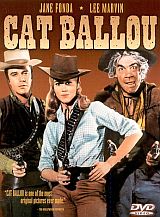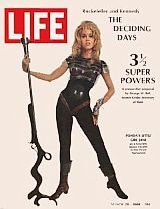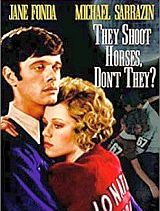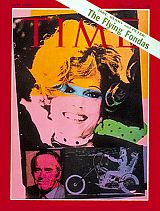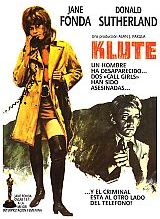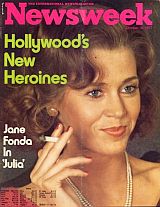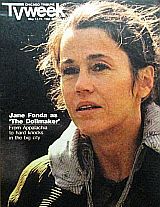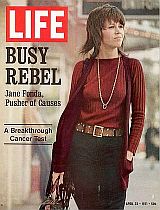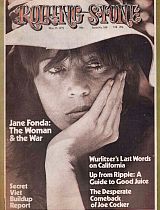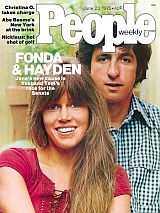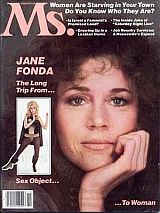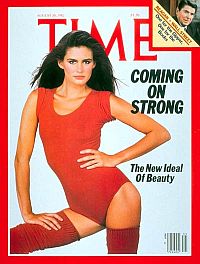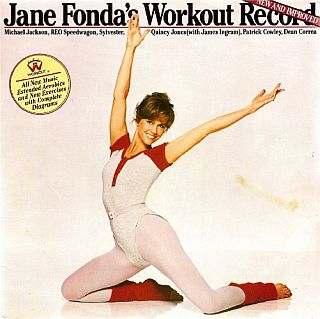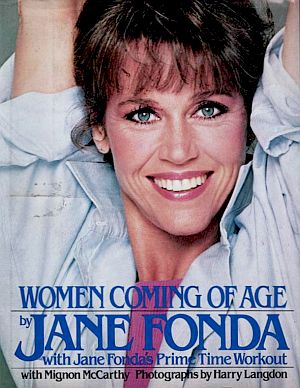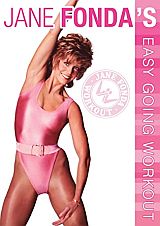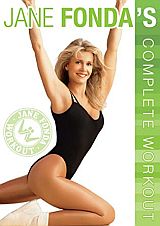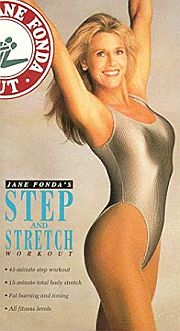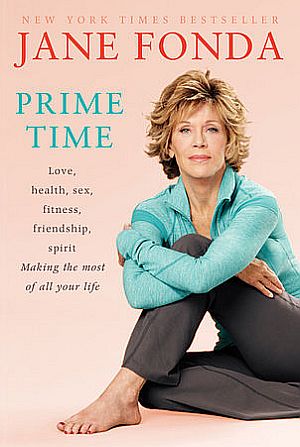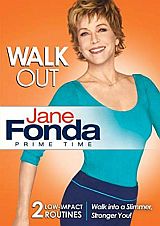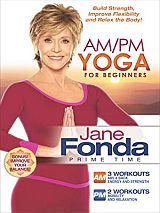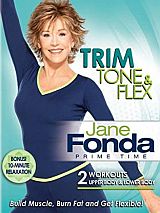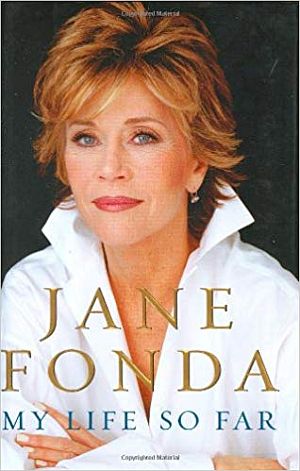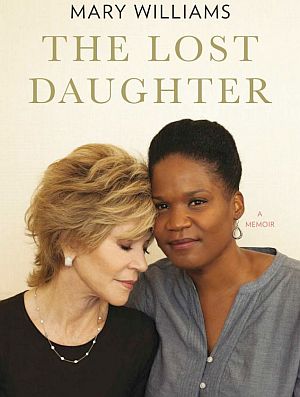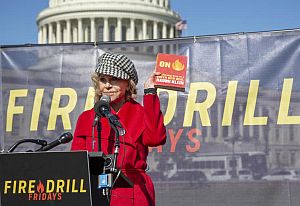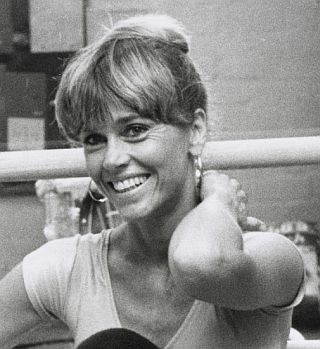
1979: Jane Fonda, with ballet exercise bar behind her.
Her rise to this position, however, was something of an accident, but it would bring her a new identity, a new career path, and a considerable cash flow. More on this part of her career in a moment; but first some biography.
Daughter of Hollywood legend Henry Fonda (who famously played Tom Joad in the film version of John Steinbeck’s The Grapes of Wrath), Jane Fonda had a difficult family life that would haunt her, but also forge her into the energetic whirlwind she later became. When Jane was 12, her mother committed suicide in a psychiatric hospital, a tragedy kept from Jane until she read about it a magazine. She strove for approval from her father, emotionally distant and demanding, as Jane bid for a perfection that would help fuel her ambition.
As a teen, Jane Fonda attended the Emma Willard boarding school in Troy, New York and then to Vassar College for two years before heading to Paris to study art briefly. Returning to New York to work as a model for a time, she twice appeared on the cover of Vogue magazine. By 1958, she attended Lee Strasberg’s Actors Studio where she was told she had real acting talent, soon earning positive notice in a few early 1960s’ stage and screen performances, including a few in France. In August 1965 she married her first husband, French film director Roger Vadim, with whom she would make films and have a daughter, Vanessa.
Meanwhile, a breakout U.S. film role had come for Fonda in the western comedy, Cat Ballou (1965) playing the lead character, Catherine “Cat” Ballou, a schoolmarm turned outlaw. This was followed by other films, including Barefoot in the Park (1967) with Robert Redford.
Then came the “sex kitten” stage, especially after her 1968 role in Barbarella, the sci-fi space film directed by her then husband, Roger Vadim, who cast her as the film’s principal character who explores space, futuristic sex, and extravagant costumes while hunting an earth-threatening villain.
Newsweek featured Fonda in a scene from Barbarella on its cover for a November 1967 story on “The Permissive Society.”
But Jane Fonda’s acting bona fides soon became clear when she was nominated for a best acting Oscar in They Shoot Horses, Don’t They? (1969), a film about marathon dancers during the Great Depression.
Two years later she won a best acting Oscar for Klute (1971), playing a New York city call girl mixed up in a murder, described recently in that role as “a major actress, with a persona all her own: empowered yet high-strung, her taut intelligence shot through with anxiety.”
Time magazine, meanwhile, had published a February 1970 feature cover story under the banner, “The Flying Fondas,” covering the Hollywood accomplishments of Jane, father Henry, and brother, Peter Fonda, who had just co-written, produced, and starred in the 1969 counterculture film classic, Easy Rider.
In 1977, Jane played famous playwright, Lillian Helman, in a story about her friendship with Julia, played by Vesnessa Redgrave, who fought against the Nazis in the years prior to World War II. Fonda was nominated, but did not win, a Best Acting Oscar, but she did win both a best acting Golden Globe and BAFTA award for her role.
In 1978, Fonda won her second best acting Oscar for her performance in Coming Home, playing a Vietnam-era Army wife who falls for a paraplegic anti-war veteran, Jon Voight. This film, and several others, were produced by her own film company, IPC, founded in 1972 with Bruce Gilbert, who had been the nursery-school teacher of Fonda’s 4-year-old daughter at the time.
Fonda started IPC, in part, because she felt “graylisted” in Hollywood — not being hired due to her activism. But IPC was also created to make films that offered important social statments. Coming Home had been inspired, in part, by Fonda’s earlier meeting and hearing Ron Kovic, a Vietnam veteran paralyzed in the war who became an anti-war activist. The film took six years to make. Another IPC film, Nine-to-Five (1980), took on the plight of 40 million female office workers.
Throughout her career Jane Fonda would appear in more than 50 films and various TV productions. In 1984, she won an Emmy Award for her performance in the IPC-crafted TV film The Dollmaker, in which she played an Appalachian mother of six who follows her husband north for work during World War II and takes up wood carving. Recently she and her long-time friend, Lily Tomlin, have appeared in the Emmy-nominated Netflix series, Grace and Frankie (2015-2018). Among some of her other Hollywood films have been: Steelyard Blues (1973), Fun with Dick and Jane (1977), California Suite (1978), The Electric Horseman (1979), The China Syndrome (1979), On Golden Pond (1981), Agnes of God (1985), The Morning After (1986), Stanley & Iris (1990), Monster-in-Law (2005), and others through the 2010s that will be mentioned later.
Apart from Hollywood, it was the political activism of Jane Fonda in the late 1960s and early 1970s that gained her as much notice as her film roles – not all of it good. For she had left some deep scars among Vietnam War era veterans, especially after a 1972 trip to North Vietnam when she appeared in an infamous photo seated in an North Vietnamese anti-aircraft gun in Hanoi, for which she later apologized a number of times (including once on ABC’s national TV show, 20/20, in June 1988 and also on 60 Minutes in March 2005) and in written explanations. Still, a derogatory “Hanoi Jane” nickname and worse would dog her for much of her life, with occasional threats and some nasty confrontations from detractors.
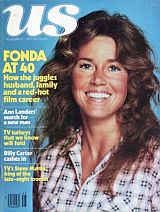 1977. US mag, "Fonda at 40". |
Activist Jane
As an anti-war activist in the late 1960s and early 1970s, Jane Fonda had the attention of the Nixon Administration, and later the FBI. She had also been lecturing at colleges in the U.S. and Canada about the war. And in Cleveland, Ohio in November 1970, after a flight from Canada, she was arrested and detained on suspicion of drug trafficking, finding in her luggage several baggies of pills. She was booked and photographed by police, told by the arresting officer that he was acting on direct orders from the Nixon White House.
Fonda would later write that Nixon’s people probably hoped that the “scandal” of catching her in a drug bust (and there were headlines), would cause her popularity as a college speaker to be ruined. But in the end, lab tests confirmed the pills were vitamins, as Fonda had said at the time of her arrest. Still, in the the battle with Nixon, Fonda might have had the last laugh, as today her mugshot from that arrest, with raised fist in protest, has become famous, an image she now uses on t-shirts, coffee mugs and other merchandise to benefit child and adolescent development. The Fonda mugshot was also used as the poster image for the 2018 HBO documentary, Jane Fonda in Five Acts, and was used on a giant billboard ad in Times Square in September 2018.
But during the early 1970s, Jane Fonda received quite extensive coverage in the popular press for her various activist involvements. Life magazine, for example, did a cover story on her in April 1971 with the tag, “Busy Rebel: Jane Fonda Pusher of Causes.” That story noted, in part:
“ …[T]here is scarcely an evil – be it racism, sexism, capitalism or the war in Vietnam – she had not taken on, nor a cause she has not espoused….Headlines proclaim her involvement in antiwar shows for servicemen, in demonstrations on behalf of welfare clients and California farm workers and Indians. She makes speeches for women’s rights and GI rights and Black Panther rights. She appears on TV talk shows, and if she turns on many of the young she turns off a great many other citizens. Publicity for herself, however, is not her aim. She is a sincere advocate, though her command of facts and complexities is unconvincing…” Her then estranged husband, Roger Vadim, called her ‘Jane d’Arc.” They were later divorced.
In January 1973, she married her second husband, Tom Hayden, the famous 1960s anti-war activist, organizer of Students for a Democratic Society (SDS), and one of the Chicago Seven defendants in the high-profile 1969 Chicago trial following the street protests at the 1968 Democratic National Convention.
By 1976 Fonda helped her husband in an unsuccessful primary challenge to then incumbent U.S. Senator John V. Tunney, with Hayden finishing a surprisingly strong second in that bid. Later that year, Fonda and Hayden founded the Campaign for Economic Democracy in California, to promote solar energy, environmental protection, and candidates for local and state political office. Hayden would later win a seat in the California Assembly.By the late 1970s, Jane Fonda appeared to be having a bit of makeover, with the movie-going public returning to her films, though her Vietnam reputation remained for many. Uneven treatment in the media (examples above) acknowledged her activism (Ms. magazine, October 1977), but also cast her in more of a mainstream role (US magazine, November 1977 “Fonda At 40: How She Juggles Husband, Family and A Red-Hot Film Career”). Through the remainder of her career, Jane Fonda would continue to fascinate and confound, with the popular press continuing to profile her in all manner of stories, from a 1988 Vanity Fair story by Tina Brown on Fonda as a repeat risk taker, to American Heritage magazine in 2001 (at left) treating her as a socio-political mirror of four decades of U.S. history.
There is a lot more detail in the many lives of Jane Fonda, some of it presented in the 2018 HBO film, Jane Fonda in Five Acts, or from Jane herself in her 2005 autobiography, My Life So Far. Suffice it to say here, briefly, that despite her critics and detractors over the years, throughout most of her life, Jane Fonda has been generous with her celebrity and her money, helping advance civil rights, women’s issues, child development, and other causes.
But one chapter of her life during the 1980s became especially interesting, presenting her with new opportunity and a new persona of sorts as she became America’s fitness queen, touching off both a fitness boom and a home video revolution. The “Jane Fonda workout” soon permeated the larger culture as her best-selling books and exercise videos swept over America. She soon had legions of fans in a new arena. In the process, a Jane Fonda business empire worth millions was spawned that both spurred new technology and boosted the economy, while helping enable her pursuit of various activist causes. What follows is a review of some of that history.

Fonda as reporter Kimberly Wells in “The China Syndrome,” a 1979 film about a nuclear meltdown. Click for DVD.
A Broken Ankle
In 1978, as Jane Fonda was filming The China Syndrome, she had something of a fortuitous accident. The film, about a nuclear power plant disaster (i.e. nuclear core meltdown i.e, “burning through the earth to China”), starred Jack Lemon, Michael Douglas and Fonda as a reporter covering the accident and revealing the dangers to the public.
But on her way to one film set, and running in high-heeled platform shoes, she fell, breaking her ankle. The producers were able to complete filming by working around Fonda’s parts and filling in later. The film, released in 1979, became an especially well-timed and propitious arrival, as an actual near meltdown was then occurring at the Three Mile Island nuclear power plant near Harrisburg, Pennsylvania.
Jane, meanwhile, had some other upcoming film roles, in two of which she had to appear in a swimsuit. Staying in shape was important to her for such film roles, and regular exercise had also became part of her life. Normally she had done ballet type exercise to stay in shape. But now, in recovery with her bad ankle, she began to look elsewhere for exercise.
Ballet to Aerobics
Exercise for Fonda, however, wasn’t new. In fact, she had been a devotee of, and believer in, regular exercise for years, focused primarily on ballet. “When I’m on a movie location, no matter where I am, the first thing I ask is, ‘Where is a ballet school?,’ she explained in a 1979 Vogue magazine story. “I’ve studied ballet in almost every country I’ve been in.” Fonda had her own philosophy to go along with the ballet routine. “People respond differently to various types of movement, to different workout speeds, even to different kinds of music.,” she told Vogue. “I like ballet and what it does for me—the slowness, the rigor, the sense of creativity while I move.”
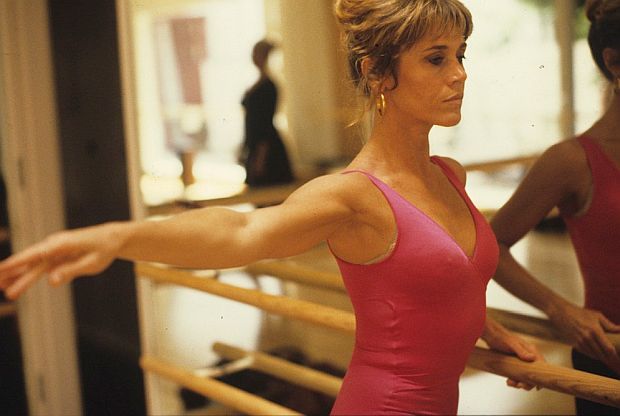
Jane Fonda, at the ballet bar, as photographed by Arthur Elgort for the 1979 Vogue magazine story, “Fitness – Fonda Style”.
After her ankle injury, her mother-in-law pointed her to an exercise class in Century City, California run by a woman named Leni Cazden who had developed an exercise technique that toned through repetitive movement backed with popular music. Fonda soon began participating in aerobics and strengthening exercises under Cazden’s direction. “Her class was a revelation,” Fonda would later write. “I entered so called adult life at a time when challenging physical exercise was not offered to women. We weren’t supposed to sweat or have muscles. Now, along with forty other women, I found myself moving nonstop for an hour and a half in entirely news ways.”
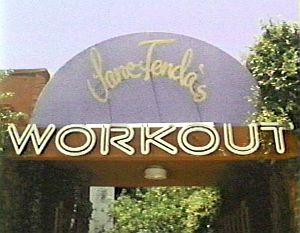
Early 1980s: Entrance to “Jane Fonda’ Workout,” her Beverly Hills exercise studio.
The Book
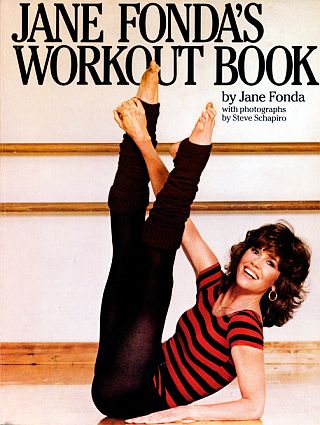
“Jane Fonda’s Workout Book,” in a 254-page hardback edition, was published by Simon & Schuster, November 1981. Click for book.
In November 1981, New York publisher Simon & Schuster issued the first edition of Jane Fonda’s Workout Book, with photos by Steve Schapiro. The 254-page hardback book, priced at $17.95, included Jane Fonda’s fitness program, designed to burn calories, improve body shape, and increase stamina and flexibility.
The book included chapters on nutrition, health, and beauty, and demonstrations of the exercises. But the book’s personal touch, incorporating some of Fonda’s own struggles and her fitness philosophy, became important elements for her audience. She also wrote about health in a broader environmental context, as she noted in the book:
…There is no way I can write about health and leave it at urging you to make a personal commitment to nutrition and exercise. […] The fact is we can only be as healthy as our ecological environment – the one true life-support system […] we must become aware of how we are being affected by our environment and what actions we can take to protect ourselves, as individuals, as communities, and as part of the whole ecosystem.
By January 24, 1982, Jane Fonda’s Workout Book was making its climb on the New York Times nonfiction bestsellers list, landing at No. 8, described as “an exercise book for women, seasoned with the film star’s philosophy of physical well-being.”
By March 13, 1982 it was No. 1 on the New York Times nonfiction list, where it would stay for many weeks. And it didn’t hurt that Time magazine jumped into the frenzy with a cover story of August 30, 1982 titled, “Coming on Strong: The New Ideal of Beauty,” picturing a Fonda-like model in exercise attire.For the year 1982, according to a New York Times survey, Robert Ludlum’s novel The Parsifal Mosaic was the biggest selling book of the year, though it had just edged out the year’s nonfiction best seller, Jane Fonda’s Workout Book.
The book was No. 1 on the bestseller list for over six months and over 16 months in the top five through 1983. By December 1983, for example, hardback copies of the book could even be found at some Eastern Newstand locations in New York city, such as: the Waldorf-Astoria Hotel, the Sheraton Centre, the Helmsley Palace Hotel, the Pan Am Building, and Rockefeller Center. After 1.3 million copies of the hardback edition were sold, Simon & Schuster issued a paperback edition in March 1984.
In writing the book, and in her exercise programs generally, Fonda researched sports physiology to understand the process of exercise. She emphasized health outcomes rather than using exercise for beauty or appearance only. And this focus on the factual basis of exercise became an appealing component of Fonda’s programs for many of her followers.

1982 record album and cassette tapes offered an “aural companion” to Fonda’s Workout Book, with music by The Jacksons, REO Speedwagon, Boz Scaggs & others. Click for CD.
LP & Cassette
Close on the heels of the book, came Jane Fonda’s Workout Record, a two-disc album featured as “an aural companion” to her best-selling book. The double disc album listed at $12.98, and suggested its users augment the record with the Jane Fonda Workout Book, then available for $17.50. The recording was also available on cassette tapes. Both were issued by Columbia Records and Tapes, a CBS company.
The Workout Record, in fact, had climbed into the Top 40 of the album pop charts in both the UK & US, peaking at No.7 in the UK and No. 15 in the U.S. In 1983, Jane Fonda’s Workout Record was the seventh biggest selling album in the U.S.
By May 1982, the headline on a full-page Billboard magazine ad, then being pitched to record dealers, noted: “‘Jane Fonda’s Workout.’ Her #1 Book is Now an Album.” The text of the Billboard ad ran as follows:
‘Jane Fonda’s Workout’ book is the #1 best-selling book in the country and has been for over thirteen weeks! To date, it has sold in excess of 350,000 copies. So be prepared for Jane’s ‘Workout’ album to take off like no other exercise record ever had or ever will!
Narrated by Jane and featuring hits by REO Speedwagon, The Jacksons, Boz Scaggs, Brothers Johnson and others, it is based on the program she advocates in the book, in Jane Fonda’s Workout health clubs, and in her many TV appearances. Included in both the album and cassette packages is a special fold-out of selected illustrated instructions.
This is one time when you’ve be in great shape if you order heavily! Remember, there are plenty of exercise records out and coming out, but only one has Jane Fonda!
Through early 1982, Jane Fonda’s book and record album were doing quite well, as were her exercise studios, generating a sizeable cash flow, some of which was being channeled through the Campaign for Economic Democracy (CED), the organization that she and Tom Hayden established in 1976. By May 1982, some of Fonda’s workout revenues were being used to help fund Hayden’s political campaign, then seeking a seat in the California legislature.
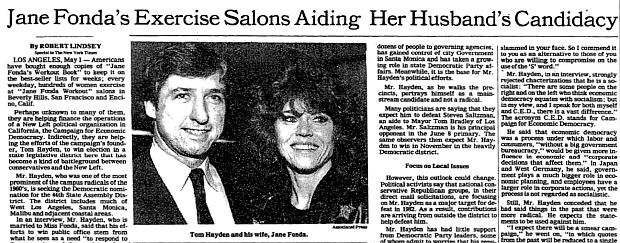
In May 1982, there were some news reports, as in this New York Times story, reporting that money from Jane Fonda’s workout studios and her book were being used to help fund her husband’s run for the State Assembly.
The CED was then financed largely by income generated from Fonda’s exercise salons and her book, which by then was the nation’s No. 1 nonfiction bestseller. Hayden at the time said that the income – about $30,000 a month – was helping finance overall operations of CED and that only a portion of his legislative campaign fund had come from the organization’s political action committee.
Meanwhile, the bigger revenue producer for Jane Fonda’s budding exercise empire – and the product that brought her the most fame and the cultural change that followed – came with the Jane Fonda exercise videos.
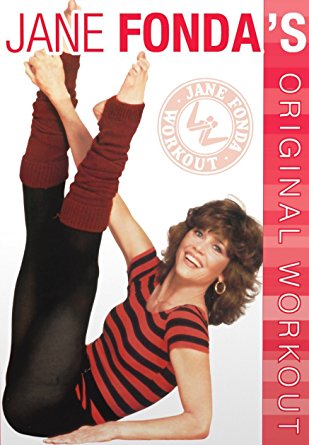
Jane Fonda original workout video, April 1982; since re-issued in DVD and digital formats. Click for DVD.
Make a Video?
In 1980, Stuart Karl, an early producer of home improvement videos, approached Fonda about making a video of the exercise routine that appeared in her workout book. On trip to New York city, Karl’s wife, Debbie, while looking at the book in a New York store window, remarked to her husband that it would be nice to work out at one’s home to avoid gym crowds. That gave him the idea of having Fonda make videos – a video made by his company. But at the time, the home video market was minuscule, and hardly anyone had or could afford a VCR player (also known as a videocassette recorder or video recorder). And besides, who would use a video over and over again?
Still, Karl believed there was a huge opportunity to create a new market for home videos somewhere between the highly commercial Hollywood films and the lurid under-the-counter world of pornography. His fledgling company, Mid-Vid, turned out a line of home improvement tapes, instructional videos, and other special titles that he described at the time as “filling the gap between Jaws and Deep Throat.” But his wife’s remark about working out at home got him thinking, and that’s when he went to talk with Fonda.
But Jane was initially reluctant about Karl’s proposal, thinking it would be bad for her career as an actor. Still, her workout studio in Beverly Hills had been going great guns. So she finally decided, “what the heck, it won’t take long, not too many people will see it and a video will bring in a little extra funding to CED.”
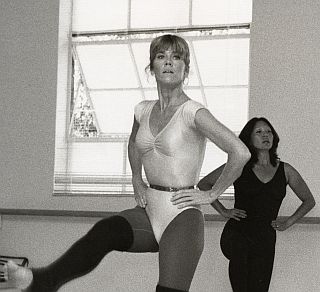
Jane Fonda leading a workout class, circa 1980s.
Fonda wrote a short script, and the video featured herself, along with some of her studio workout teachers and clients doing the workout. They did their own hair and makeup, had one camera, and after a few takes, they had their product.
“We did it in three days, we hardly had any rehearsal, we had no hairdressers — when I look at how we do it now compared to then, it was funny,” she would later recall. On April 24th,1982, Jane Fonda’s Workout video hit the streets. Within a few months, it sold more than 300,000 copies — and it kept selling.
The first workout video included a 30 minute beginners’ class and a 60-minute advanced session, with segments for toning arms, waist, abdomen, legs and hips. The workout was designed to build strength, develop flexibility, and increase endurance.
 Jane Fonda in beach scene from 1979-80 film, “California Suite,” a Neil Simon comedy with Alan Alda and others. |
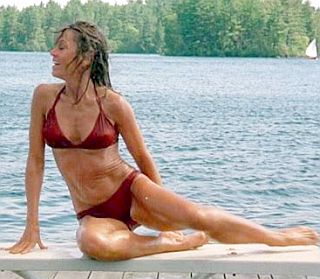 Jane Fonda in dock scene from 1981 film “On Golden Pond,” right before the island mail boat arrives. |
The Best Advertisement
“Look Like Jane”
In her 40s at the time of the first video’s release in 1982, Jane Fonda became “a perfect advertisement for herself,” as one reviewer would put it. And in her writing and verbal instruction, Fonda came across in a non- threatening way, and was all business in her exercise routines, becoming famous for certain phrases, such as, “feel the burn.” Her natural beauty was also an asset, and she drew women to her as they trusted her familiar face over that of strangers. Her Hollywood films also helped sell the Jane Fonda exercise materials.
Swimsuit appearances in two of her movies during 1979-1982 (shown at left) certainly did not hurt sales of her book and video – one beach appearance in California Suite, a Neil Simon comedy released late December 1979 with Alan Alda, Michael Caine, Richard Pryor and others; and another on a lake dock in On Golden Pond, released in 1981, starring her father, Henry Fonda and Katherine Hepburn.
Fonda, then in her early 40s, looked fit and healthy in her swimsuit scenes, evidence enough for many women to get on the workout bandwagon and buy the Jane Fonda book and video.
Jane Fonda’s Workout became the highest selling home video of the early 1980s, with over a million copies sold. A Fonda-led fitness craze swept the country. The video’s release led many people to buy then new VCRs in order to use the workout at home. VCR sales jumped, helping advance the home video revolution.
Jane Fonda had tapped into a gold mine of female frustration, as in those days there were few places for women to work out, or even to know what kind of exercise to do. Gyms were primarily designed for men, as were weights and most exercise equipment. There was also something of stigma attached to women working out; women “weren’t supposed to sweat,” as Fonda would say.“Part Murphy Brown, part Teddy Roosevelt, the ’80s Fonda was a solid role model for entrepreneurial feminists & career moms.” But with the Baby Boomer females of that era, Fonda found a willing and eager audience, and a huge market. And for Fonda image-wise, her exercise leadership contributed to an elevation of her reputation and national standing, especially among women. One 1984 World Almanac listing identified her as the country’s third most influential woman, and a 1985 Gallup poll ranked her fourth on a list of “America’s Most Admired Women.” Writing in American Heritage magazine in 2001, Peter Braunstein described her as: “Part Murphy Brown, part Teddy Roosevelt, the eighties Fonda was a solid role model for entrepreneurial feminists and career moms.” Meanwhile, the Jane Fonda fitness craze of the 1980s was just hitting its stride at mid-decade, as more Jane Fonda books and videos were on the way.
In 1984 there was, Women Coming Of Age With Jane Fonda’s Prime Time Workout, written with Mignon McCarthy, which also had a companion video. The book included chapters titled: “Women In Midlife,” “The Body Mature,” “Is There Life After The Menopause?,” “My Program For Midlife Well-Being,” and “Prime Time Workout.” This book also had a 1985 Viking Press edition published in Great Britain.A couple of yearbook/desk calendar-type publications also came out: Jane Fonda’s Year of Fitness, Health and Nutrition, 1984, a 192-page spiral bound book published by Simon and Schuster. And another similar volume for the following year in hardcover, Jane Fonda’s Year of Fitness, Health and Nutrition, 1985 published by Holiday House.
By the early mid-1980s, it was clear that Jane Fonda, on her exercise ventures alone, had penetrated popular culture in a major way. Observes James Michael Rafferty in a British PhD thesis paper he wrote on Fonda in 2010, “Politicizing Stardom”:
“…The cultural impact and commercial success of The Workout cannot be overstated… By April 1984, [the Jane Fonda workout video] had sold approximately 275,000 copies at $60 each, making it the biggest selling non-musical video in American history. This earned the CED-owned Workout Inc. approximately $2 million. Jane Fonda’s Workout Book sold two million copies in hardcover at $19.95 each and was on the Publishers Weekly bestseller list for ninety weeks; the trade paperback version sold more than 250,000 copies at $9.95 each. Jane Fonda’s Year of Fitness and Health/1984 desk diary, which retailed for $8.95, had two print runs totaling 250,000 copies.
Jane Fonda Workout and Active Wear, manufactured by Capri Beachwear Corporation in partnership with Fonda, was being carried by Saks Fifth Avenue and nearly one hundred major retail outlets across the nation; the clothing line was projected to gross more than $30 million in 1984 alone….
Yet, through the remainder of the 1980s and beyond there was more to come. In 1986, she revised her workout book with a new version – Jane Fonda’s New Workout and Weight Loss Program — released in June that year (Simon & Schuster 254 pages).
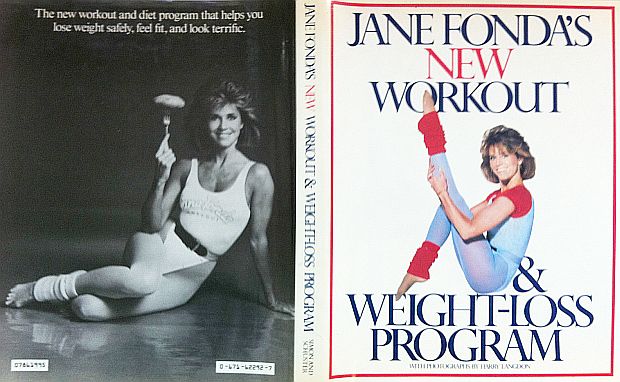
1986: New book, “Jane Fonda's New Workout and Weight Loss Program,” released in June 1986, by Simon & Schuster, 254 pages, with a trim Jane Fonda on the back cover holding a vegetable on a fork as a diet prompt. Click for book.
New York Times writer and columnist, Jane Brody, who then wrote a personal health column, reviewed Jane Fonda’s New Workout and Weight-Loss Program book in mid July 1986, noting: “At last a celebrity has proposed a weight-loss program that is sensibly slow, nutritionally sound, appropriately flexible and readily adaptable for a lifetime.” The updated version of the Fonda workout book put more stress on the role of a healthy diet and suggested a weight-loss program high in fiber and complex carbohydrates and low in fat. A sample menu was also provided. But the book’s major focus was the exercise routines.
Videos Boom
By 1986, Fonda sold over $4 million worth of fitness videos alone. And through the 1980s and into the 1990s, more Jane Fonda videos and books would come as well. Displayed here at right are the covers of some of her classic exercise videos, first produced in the 1980s, but later remastered and re-issued in DVD format. (Click on images for DVDs or videos).
Jane Fonda’s Easy Going Workout (1985), was designed for those who found her other tapes, especially the original Workout video, too difficult and needed a slower workout program. It is a mild, but challenging routine that offers upbeat music & easy-to-follow choreography.
Jane Fonda’s New Workout (1985), her fifth workout video, was designed as an improved version of her original workout program. It offers a 35 minute beginners’ class with 12 minutes of aerobics and a 55 minute advanced class with 16 minutes of aerobics. Each class begins with a warm-up, proceeds to work the waist, arms and aerobics, floor stretch, abdominals, legs and hips, buttocks, and ends with a cool-down.
In 1986, she released Jane Fonda’s Low Impact Workout, offered an alternative to her other aerobic classes with high intensity moves. The classes in this video include a 6 minute warm-up, 35 minutes of low impact aerobics, and a 10 minute stretch cool-down.
Jane Fonda’s Complete Workout was released in 1988, and was designed by Fonda as her new overall exercise class to replace her original and New Workout classes. This program offers a half hour of aerobics which can be done at high or low intensity, or alternating between the two for an interval training effect to maximize fat burning. Upper and lower body toning segments precede and follow the aerobics which can be done with or without dumbbells or ankle weights.
|
Fonda Fitness Empire Videos: Books: Records & Tapes: |
By the early 1990s, Jane Fonda’s video line had workouts for just about everyone. There was a standard aerobics video, a workout with weights, workouts that were less vigorous and low-impact, as well as workouts for those in good shape and could deal with Jane Fonda’s Workout Challenge. There were also videos for children and pregnant women, as well as women recovering from childbirth.
So why all the videos? “This is a repeat thing, “ Jane would later explain, “I mean, people use it two, three, four, five times a week, and after a year, they want new music, a few new steps. And so we do a lot of market research to determine what it is now that people want.”
By December 1990, Jane Fond was in New York promoting her 12th workout video, Jane Fonda’s Lean Routine. She told the New York Times reporter at that time: “I never could understand why after a long 15-hour day on the sound stage everyone would be real tired Instead of going home I’d go to dance class and study ballet for a few hours and at the end of that I would feel so great, like I just had a good night’s sleep. Thirty years later, I understand that when you’re exercising strenuously, a chemical is released in the body called endorphin, which gives you a natural high. It also helps relieve stress, fatigue and depression.”
Her new video explored some new exercise territory while also offering diet advice. “I hadn’t yet done a 60-minute aerobic program using interval training, which is now considered the best way to burn fat,” she said at the time, referring to a system where a few minutes of light exercise are interspersed with periods of intense exercise.
“If we’re asking people to do that, we also have to tell them that exercise goes hand in glove with proper eating and dieting. And that doesn’t mean crash diets, which are totally counterproductive. I wanted to explain how to eat and diet properly so that you really are getting on a lifelong program and not just a roller coaster ride.”
On her Lean Routine video Fonda discusses, among other things, why aerobics is considered the safest and most effective way to burn calories, how weight control is fat control, the advantages of healthy living, and guidelines for good eating habits.
By April 1991, Fonda closed her Beverly Hills, workout studio, in part due to increasing competition but primarily to concentrate on her core businesses of fitness videos, books and audiotapes. At that time one UPI report estimated her empire to be worth $100 million.
It was around this time that Fonda had met her third husband, Ted Turner, cable-TV maverick and CNN founder, who she would marry in December 1991, with her life then taking another new turn, as she would put down some roots and make certain philanthropic and community commitments in the Atlanta, Georgia area.
Back in the workout business, meanwhile, by 1992 she had issued some 15 tapes that had sold about 9 million copies. That year she issued her second video on step aerobics, which involves the use of a small platform or step. Fonda, who formerly conducted some classes at her workout studio, was no longer leading the aerobics sessions on her tapes, but was still doing the floor exercises on the videos. She was still working out four times a week by then, but just didn’t have the time to memorize and rehearse the aerobics routines. The video taping for her exercise videos by this time — more than a decade after her first video – was now much more of a production and took about a year to complete. In the earlier tapes, Fonda had been the principal choreographer, but now most of the routines were created by staff members with input from Fonda, as well as a physiologist and a cardiologist.Other celebrities had come to the market with their own exercise videos of one kind or another, as the Fonda tapes faced competition. Still, during 1991-1994 she issued five more exercise videos: Lower Body Solution; Step Aerobic and Abdominal Workout; Favorite Fat Burners; Yoga Exercise Workout; and Step & Stretch Workout.
By 1995, as sales of the videos slowed, the Fonda workout managers and sales folks were adopting other strategies. “Fonda’s Personal Training Center” – a retail store kiosk that included videos, clothes, and fitness equipment – was installed at 1,000 locations, including Target, Oshman’s, Big 5 Sporting Goods and Sportsmart. There was also “bundling” of the video tapes with exercise equipment, as Fonda’s business manger La Fond reported to Billboard magazine. “Of the 2 million units sold on Fonda’s “Step Aerobics,” explained La Fond, “1.5 million were sold with the step.”
Jane Fonda, meanwhile, in her personal life had separated from Ted Turner and began living at her own ranch and working on her memoir. By May 2001, her divorce from Ted Turner was final, though the two have remained friends. After she finished writing the manuscript for her memoir, she began to think about making a return to acting. But at 65, that would be a pretty hard sell, but by 2005, she made her first out-of-retirement movie, Monster-in-Law with Jennifer Lopez. That same year, Random House published her autobiography, My Life So Far, which prompted a Washington Post reviewer to conclude that Jane Fonda is a “beautiful bundle of contradictions.” The New York Times called her book, “achingly poignant.” Also around this time, some of her older workout videos were re-released in DVD.
But Jane Fonda was not finished with her wellness acts just yet.
Fitness & 3rd Acts
Although her exercise videos from the 1980s and 1990s were still available in VHS format, and some remastered and issued in digital formats, Fonda decided to hit the exercise market once again in 2010. This time, she would be focusing on seniors living in their “prime time” years. First came two new fitness videos released on DVD in 2010. And there was also a new book to dovetail with the videos – Prime Time: Love, Health, Sex, Fitness, Friendship, Spirit; Making the Most of All of Your Life. It was a new call to her audience that focused on living one’s life fully in the final years. This book followed upon her 2005 best seller, My Life So Far, as Jane explains:
…In my memoir, My Life So Far [2005], I defined my life in three acts: Act I, from birth to 29 years; Act II, from 30 to 59 years; and Act III, from 60 until the end. It really seemed to resonate with people, and a few years after the book came out, my editor at Random House, Kate Medina, came to me and suggested I write a book focusing more on the Third Act. I was interested in doing this because I was already well into my Third Act and relished the challenge to dig deeper, to understand its meaning, to learn how to make the most of it, and to navigate the inevitable challenges of aging–what is negotiable and what isn’t….
The videos – two issued in 2010 and three more in 2011-2012 – targeted the boomer and senior population to help them stay fit as they aged. Brief summaries of four of those videos follow below. (Click on images for DVDs or videos).
In 2010, Jane Fonda: Prime Time–Walkout was released. It includes two one-mile walking workouts. Also released in 2010, Jane Fonda: Prime Time – Fit & Strong, was also aimed at seniors and includes two 25-minute workouts aimed at burning fat, toning and shaping muscles, and core strengthening.
In 2011, came Jane Fonda Prime Time: Trim, Tone & Flex, which emphasized the importance of staying strong and flexible in aging, focusing on stretching to help promote weight loss and also protect bones and reduce joint stress. IT includes upper- and lower-body workouts.
Also in 2011, Jane Fonda Prime Time: Firm & Burn Low Impact Cardio was released, using several programs of dance routines to Doo-Wop, Latin, Funk and other music to get folks moving in 5 and 10 minute defined segments.
In 2012, Jane Fonda AM/PM Yoga for Beginners was released. This video includes three morning workouts and two evening workouts. Says Jane: “It’s time to get a yoga body! I love doing yoga in the morning to wake up my body and again at night to unwind from the day. Yoga is a great way to enhance your energy build strength and increase flexibility. Join me for my series of three AM yoga workouts designed to make you feel rejuvenated and energized and two PM workouts that will help you relax unwind and release tension and stress.” This video includes a 5-minute bonus section on stability and posture exercises to improve balance.
The Fonda Cohort
In the end, Jane Fonda had tapped into a market that has grown and aged along with her – mostly around the Baby Boomer cohort, but edging into demographics on either side of that group as well. For it was the thirty- and forty-something boomers from the 1980s who first bought her books and videos, and who then became the fifty- and sixty-somethings in the 1990s and 2000s, and as this is written, even the seventy- and eighty-somethings in the 2010s. At each of these stages there was some kind of Jane Fonda book or exercise video — and/or living advice in later years — to help keep her followers active and interested. It proved to be a prosperous and magic demographic for her. A bonus, of course, is that fair numbers of non-boomers became a part of Jane’s market too, in some cases, as the children of boomers also used Jane Fonda tapes and read her books, and possibly even a few millennials have now ventured there as well.

1979. Jane Fonda working out with others, as photographed by Vogue magazine.
Nor should Fonda’s exercise success and business empire be considered a ‘60s activist “sell out.” Certainly for Fonda herself, her books and tapes were always about female empowerment – bringing fitness and health to women as first steps in the broader empowerment process – and happily for her, also an avenue for proselytizing on diet, the environment, and other issues. It was, for her, all of a consistent piece — an honorable way of doing well while doing good; it all fit together. And it also became something of a built-in market for her autobiography, later books, films, and TV shows.
The success of her workout venture over the years also became an important enabler for her – a financial enabler worth millions every year, complimenting her acting and film production income and providing the means to continue her activism while living a comfortable celebrity life. Moreover, the additional celebrity that accrued to her by way of her workout fame through the 1980s and beyond, only added to her impact and reach on various activist causes. And the publicity she has received, and continues to receive, at activist events (see below), and for her support of social causes and activist organizations, reinforces her celebrity and activist standing.
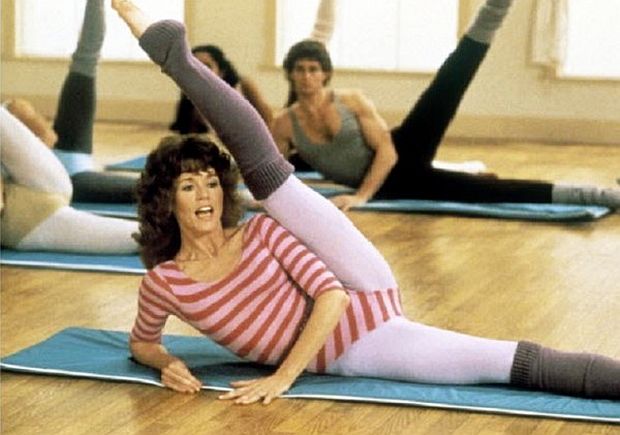
Jane Fonda, at one of her workout studios, leading a group in floor exercise, circa 1980s.
It’s also turned out that her exercise business gave Jane Fonda entrée to a giant constituency of sorts – a base of followers who not only listened to her fitness advice, but also her “bigger-picture” messages on diet, health and the state of the environment. Certainly not all of Fonda’s fitness audience were in lockstep with her views. No doubt more than a few of her fitness followers loved her workout routines but hated her politics. Still, many likely at least gave her a listen. And combined with her Hollywood film and later TV audiences, Jane Fonda over the years has had a bigger base than many national politicians.
Jane Fonda’s film career, meanwhile, has continued into her later years. After Monster-in Law of 2005, Fonda made ten more Hollywood films, among them: Georgia Rule (2007), All Together (2012), Peace, Love & Misunderstanding (2012), The Butler (2013), in which she plays Nancy Reagan; Youth (2015), for which she was nominated for a Golden Globe for Best Supporting Actress; Our Souls at Night (2017 /Netflix), with Robert Redford; and Book Club (2018), about a group of senior women reacting to the book, 50 Shades of Grey, also starring Diane Keaton, Candice Bergen and Mary Steenburgen.
In her television work, Fonda has been a guest actress appearing in the series, The Newsroom (2012-2014), and is also co- starring with Lilly Tomlin in the series, Grace & Frankie (2015-2018), for which she and/or Tomlin have received several Emmy and other nominations.
During her earlier film career Fonda had won her profession’s highest acting awards, including two Oscars, two BAFTAs, and four Golden Globes, among others.
Activist Life
Whatever might be said about Jane Fonda, one thing is for sure: she has not stood still. Her friends, former husbands, and fellow actors throughout her life have been amazed at her energy and the many causes she undertakes. One reviewer of her 2005 autobiography remarked at being “astonished by how much living can be packed into sixty-plus years.” Indeed, Jane Fonda has marked every decade in which she has lived; leaving a little “Fonda dust” wherever she ventures. Her activism of the 1960s and 1970s — though not always well-received — was no one-time occurrence, and it continues as this is written. She has a long history of supporting women’s rights, environmental protection, and childhood development, and often travels far and wide to participate in protests, conferences, and marches on these and other issues.
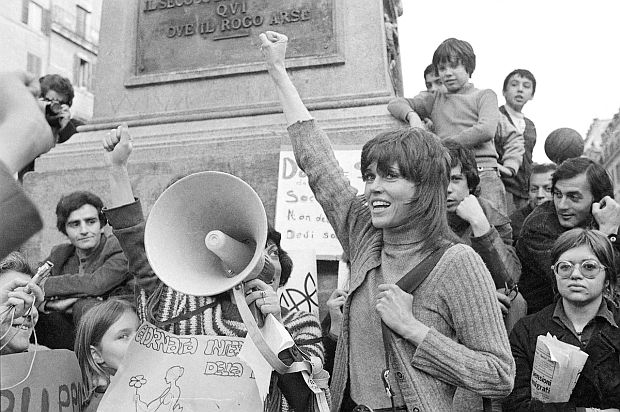
1972. Jane Fonda in Rome, Italy supporting a rally on behalf of Italian feminists. photo, Associated Press.
In May 1979, she was among speakers supporting anti-nuclear power protests in Washington following the Three Mile Island accident in Pennsylvania. In the mid-1990s she established the Georgia Campaign for Adolescent Power and Potential and the Fonda Family Foundation in the late 1990s. In 2001, she established the Jane Fonda Center for Adolescent Reproductive Health at Emory University in Atlanta to help prevent adolescent pregnancy. She has also been a longtime supporter of feminist causes, including V-Day, a movement to stop violence against women, inspired by the off-Broadway hit The Vagina Monologues.

May 1979. Jane Fonda flanked by Governor Jerry Brown of California (left), and her husband, Tom Hayden, at anti-nuclear power protest rally in Washington D.C., which occurred shortly after the Three Mile Island nuclear accident in Pennsylvania and as ‘The China Syndrome’ film was still running in theaters.
In mid- February 2004, Fonda led a march through Ciudad Juárez, Mexico with Sally Field and others urging Mexico to provide sufficient resources to investigate the murders of hundreds of women in that city. In 2005, along with Robin Morgan and Gloria Steinem, she co-founded the Women’s Media Center, an organization that works to amplify the voices of women in the media. Fonda serves on its board.

2015. Jane Fonda holding a 'Stop Shell' protest sign at an anti-oil development gathering in Vancouver, British Columbia.
In June 2015, she joined protests in Vancouver, British Columbia regarding Shell Oil’s drilling plans in offshore Alaska as well as expected oil tanker traffic off the British Columbia coast. In July 2015, she marched in a Toronto protest called the “March for Jobs, Justice, and Climate.”
In November 2016 she helped lead a protest against the Dakota Access Pipeline crossing the Standing Rock Indian Reservation in North and South Dakota (and later withdrew her money from Wells Fargo bank, one the project’s funders).
In January 2017 she stood with Greenpeace and First Nation groups opposing expansion of tar sands development in Alberta, Canada. Fonda’s protests on various oil projects are often met with vitriol by many in the oil industry, but she says she is working on behalf of her grandchildren and wants to make sure “I did every single possible thing I could do to make their world a liveable world.”
Back in Hollywood, meanwhile, Fonda was honored in 2014 with the AFI Life Achievement Award, and in 2017 she received the Golden Lion for Lifetime Achievement at the 74th Venice Film Festival. As this is written, Jane Fonda shows no signs of slowing down, planning to continue both her advocacy and her acting. Indeed, by October 2019, nearing age 82, Fonda moved temporarily to Washington, D.C. to begin a series of global warming protests on the steps of the U.S. Capitol under the banner, “Fire Drill Fridays,” inspiring others to join her, including Ted Danson, Diane Lane, Piper Perabo, Manny Jacinto, and Ben Cohen and Jerry Greenfield (of Ben & Jerry’s ice cream). As of November 2019, Fonda had led at least seven of the protests, as she and others have been arrested, spending some nights in D.C. jails.
See also at this website, “Noteworthy Ladies,” a topics page with dozens of story choices on the lives of famous women in various fields. See also the “Film & Hollywood” page or the “Environmental History” page for stories in those categories. Thanks for visiting – and if you like what you find here, please make a donation to help support the research and writing at this website. Thank you.
– Jack Doyle
|
Please Support Thank You |
____________________________________
Date Posted: 27 September 2018
Last Update: 30 March 2024
Comments to: jackdoyle47@gmail.com
Article Citation:
Jack Doyle, “Fonda Fitness Boom: 1980s & Beyond,”
PopHistoryDig.com, September 27, 2018.
____________________________________
Sources, Links & Additional Information
 Cover art for earlier Jane Fonda biography by Thomas Kiernan, Jane: An Intimate Biography of Jane Fonda, New York: Putnam, 1973. |
“Jane Fonda Biography,” JaneFonda.com.
“Jane Fonda Filmography,” Wikipedia.org.
Jane Fonda, My Life So Far, New York: Random House, 2005 / London: Ebury Press, 2005.
Mary Hershberger, Jane Fonda’s War: A Political Biography of an Antiwar Icon, New York: The New Press, 2005.
Sean French, Jane Fonda: A Biography, London: Pavilion, 1997.
Michael Freedland, Jane Fonda: A Biography, London: Weidenfeld and Nicolson, 1988.
Fred Lawrence Guiles, Jane Fonda: The Actress in Her Time, New York: Doubleday, 1982.
Thomas Kiernan, Jane Fonda: Heroine for Our Time, New York: Delilah Communi-cations, 1982.
Gary Herman and David Downing, Jane Fonda: All American Anti-Heroine, New York: Quick Fox, 1980.
Thomas Kiernan, Jane: An Intimate Biography of Jane Fonda, New York: Putnam, 1973.
Stephen H. Dunphy, “Jane Fonda Uses ‘Leverage’ to Aid Cause of Indian Rights,” Seattle Times, Sunday, March 8, 1970, p. A-20.
Barb Jacola, “Fonda’s Theory: Peaceful Revolt,” The BG News (Bowling Green, Ohio), November 5, 1970, p. 1.
John Frook, “Jane Fonda, Nonstop Activist,” Life, April 23, 1971, pp. 50-55.
Robert Windeler, “Jane’s New Cause,” People, June 23, 1975.
Donald R. Katz, “Jane Fonda Is a Hard Act to Follow; With Husband Tom Hayden, The Actress Is Trying to Move Past the ‘Hanoi Jane’ Tag,” Rolling Stone, March 9, 1978.
Paul W. Valentine, Karlyn Barker, Thomas Morgan, and others, “The Protesters,” Washington Post, May 7, 1979.
Michael J. Weiss, “Biggest No-Nuke Rally Rocks Washington,” Circus Weekly (magazine), June 12, 1979.
Warren Taylor, “’On Golden Pond’ Sappy, Highly Overrated… Despite Fine Performance From H. Fonda,” Connecticut Daily Campus, March 23,1982, pp. 4-5.
Aljean Harmetz, “Jane Fonda: She Makes Ideas Pay at Box Office,” New York Times, March 25, 1982.
Robert Lindsey, “Jane Fonda’s Exercise Salons Aiding Her Husband’s Candidacy,” New York Times, May 2, 1982.
Richard Harrington, “In Tone With the Music,” Washington Post, May 22, 1982.
“Hayden Seeks to Erase Angry 60’s Image,” New York Times, October 14, 1982.
Diane White, “Fonda, Feminism and Fitness,” Boston Globe, December 3, 1982.
S. Aljean Harmetz, “Sales of Movie Cassettes for Home Use Rising,” New York Times, June 27, 1983, p. 1.
Douglas Thompson, “What Fitne$$ Means to Fonda,” The Mail On Sunday, October, 30, 1983.
Jane Fonda and Mignon McCarthy, Women Coming Of Age With Jane Fonda’s Prime Time Workout (Harry Langdon, photographer), New York: Simon & Schuster, 1984.
Tony Seideman and Marc Zabatkin, “Jane Fonda’s Workout Titles Keep Flexing Their Muscles on Sales Chart,” Billboard, November 30, 1985, pp, 27-29.
“Walking Out On Jane Fonda’s Regime,” The Times (London), September, 1, 1986.
Jane Brody, “Personal Health” (part review of Jane Fonda’s New Workout and Weight-Loss Program book, New York Times, July 16, 1986, p. C-8.
Nick Ravo, “Jane Fonda Finds Peace in Her Time,” New York Times, August 4, 1988.
Helen Dudar, “Barbarella’s Progress,” Review of Citizen Jane: The Turbulent Life of Jane Fonda, By Christopher Andersen, New York Times, June 10, 1990.
Christopher Andersen, Citizen Jane: The Turbulent Life of Jane Fonda, New York: Donald Hutter /Henry Holt & Co., 1990, 389 pp.
“Fonda’s View of Food: Live Without the Fat,” New York Times, December 24, 1990.
Elaine Louie, “Currents; Children Staying Fit With Fonda,” New York Times, January 31, 1991,
Alan Citron, “No Sweat: Jane Fonda Closes Her Beverly Hills Aerobics Studio,” Los Angeles Times, April 3, 1991.
UPI Archives, “Jane Fonda Closes Aerobics Studio,” April 3, 1991.
Susan Heller Anderson, “Chronicle: Jane Fonda Closes Her Workout Studio…”, New York Times, April 4, 1991, p.46.
Yardena Arar (Los Angeles Daily News), “Jane Fonda Exercises Sound Business Sense with Workout Tapes,” Baltimore Sun, September 20, 1992.
Peter Braunstein, “Ms America, Why Jane Fonda is A Mirror of the Nation’s Past 40 Years,” cover story, American Heritage, July/August 2001.
Emma Brockes, “’I Give Off Sparks’,” TheGuardian.com (interview), April 4, 2005.
“Jane Fonda Is Interviewed about Her Book, ‘My Life So Far’,” Hardball With Chris Matthews, Aired: April 15, 2005.
David Sheff, “Whatever Happened to Jane Fonda in Tights?,” New York Times, February 8, 2007.
James Michael Rafferty, “Politicising Stardom: Jane Fonda, IPC Films and Hollywood, 1977-1982,” Thesis submitted for the qualification of Doctorate of Philosophy (PhD), Queen Mary, University of London, 2010.
“Two Books, One Woman: Jane Fonda,” Vogue.com, August 9, 2011.
“The Decade That Made Us: Lift Off” (1 of 6), YouTube.com.
“Jane Fonda, Biography,” IMDB.com.
“Jane Fonda, Credits,” TVguide.com.
Hilton Als, “Queen Jane, Approximately; How Jane Fonda Found Her Way Back to Acting,” The New Yorker, May 9, 2011.
“30th Anniversary of My First Workout Video,” JaneFonda.com, April 24, 2012 (24 Comments).
Peter Krämer, “From Vietnam to Video: Notes on Jane Fonda’s Films and Activism, 1970-1982,” Women’s Film and Television History Network, November 22, 2013.
Lacey Gattis, “Jane Fonda’s Workout Book”(with slide show), IntoTheGloss.com, 2014.
Melanie Pruit, “On Golden Fonda,” Confes-sions of a Movie Queen, June 10, 2014.
April Braden, “Women Don’t Sweat, They Glisten: Jane Fonda and The Commer-cialization of Aerobics In the 1980s,” US historyScene.com.
“Jane Fonda Filmography,” Wikipedia.org.
David Kipen, “Magnetic Men, Vietnam, Aerobics, Religious Epiphany — Jane Fonda Has Lived Through Enough to Fill a Book,” Review of ‘My Life So Far’,” San Francisco Chronicle, Friday, April 8, 2005.
“Jane Fonda’s Workout Launched a Revolution; 1982: Jane Fonda’s Workout Comes Out on VHS,” Bloomberg.com, December 4, 2014.
Michael d’ Estries, “Jane Fonda’s Workout Series to Go Digital for a New Generation; the Original ‘Jane Fonda’s Workout’ Video Remains the Top-Grossing Home Video of All Time,” MNN,com, January 2, 2015.
“Jane Fonda, Now More Than Ever,” cover story, DuJour.com, Spring 2015.
Jake Rossen, “How Jane Fonda’s Workout Conquered the World,” MentalFloss.com, June 19, 2015.
Ree Hines, “Get Your Legwarmers Ready! Jane Fonda’s Classic Workout Videos Are Back,” Today.com, October 14, 2016.
Zoe Ruffner, “Jane Fonda’s 1979 Fitness Advice Is the Secret to Looking Good Forever,” Vogue.com, December 21, 2016.
“Jane Fonda Fast Facts,” CNN.com, updated, January 23, 2018.
“Jane Fonda The Chameleon,” Blogspot.com, April 2007.
Noah Berlatsky, “Fire Up the Orgasmatron: Why We Can’t Let Barbarella Go,” TheGuardian.com, October 5, 2016.
Catherine Shoard, “Jane Fonda: ‘Plastic Surgery Bought Me a Decade’,” TheGuardian.com, May 21, 2015.
Brooks Barnes, “Jane Fonda Has Always Been on the Move — And She Has No Plans to Slow Down Now,” TownAndCountrymag.com, Oct 12, 2017.
Owen Gleiberman, “Sundance Film Review: ‘Jane Fonda in Five Acts’ is an Enjoyably Candid Documentary; the Fabled Star and Activist Gazes Back on a Life of Shifting Roles That Now Looks More Timely Than Ever,” Variety.com, January 21, 2018.
Danielle Friedman, “The History Behind Women’s Obsession With Working Out,” HarpersBazaar.com, February 14, 2018.
Patricia Bosworth, “Jane Fonda Is 80 and Still Conquering Hollywood,” VanityFair.com, April 10, 2018.
Patricia Garcia, “Jane Fonda’s 1982 Workout Routine Is Still the Best Exercise Class Out There,” Vogue.com, July 7, 2018.
As Told to Alison S. Cohn, “Jane Fonda Opens Up About Her Ageless Style; The Actress Has Defined Her Signature Look on Her Own Terms,” HarpersBazaar.com, September 20, 2018.
____________________________________
